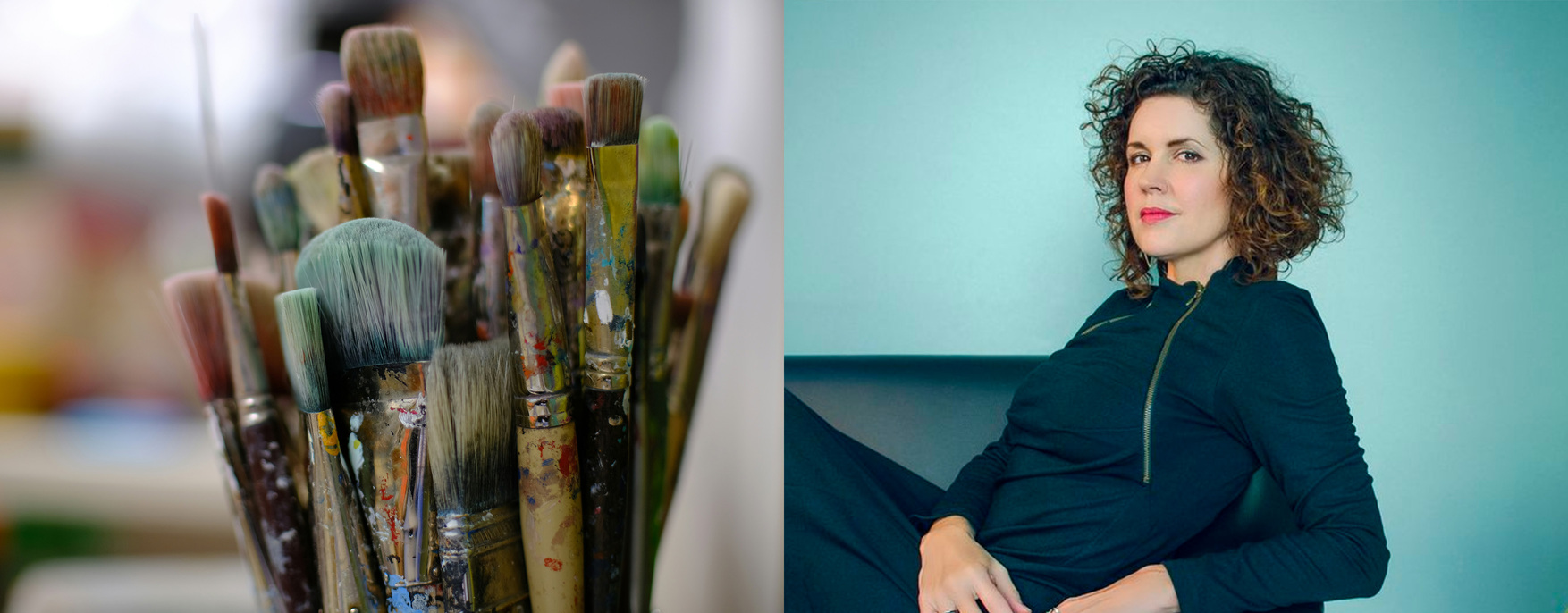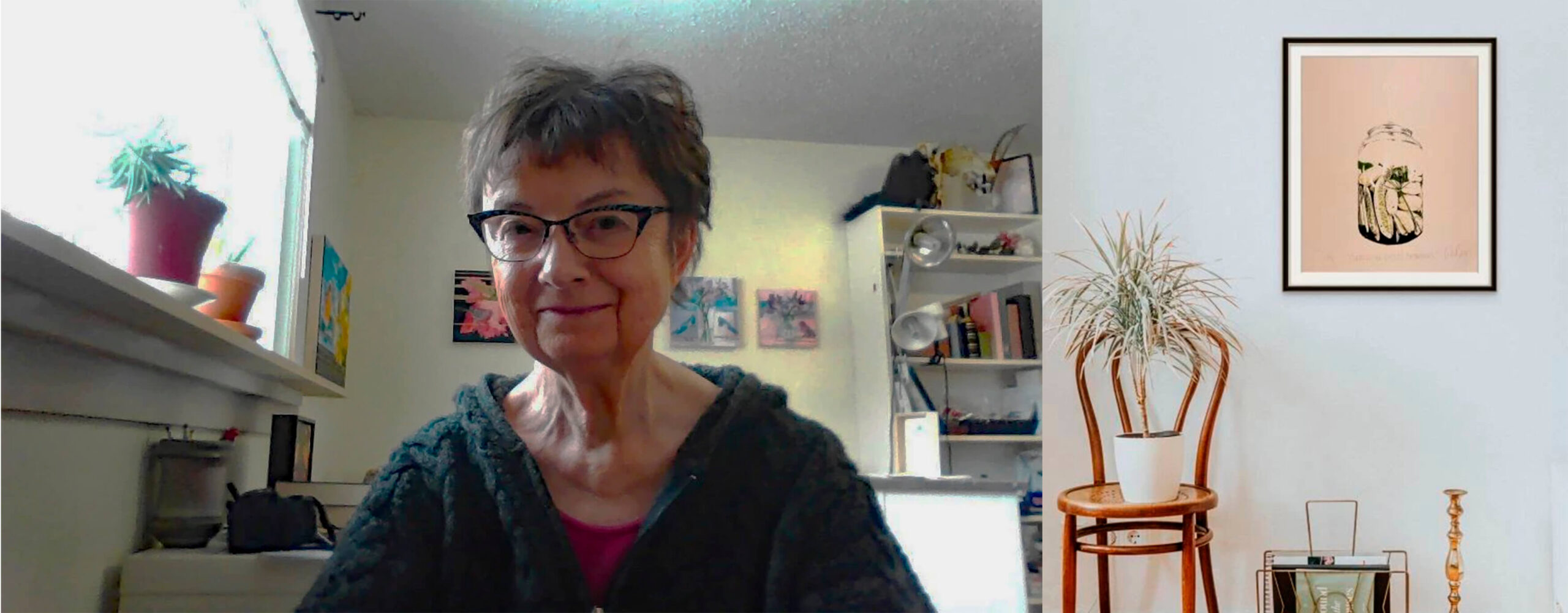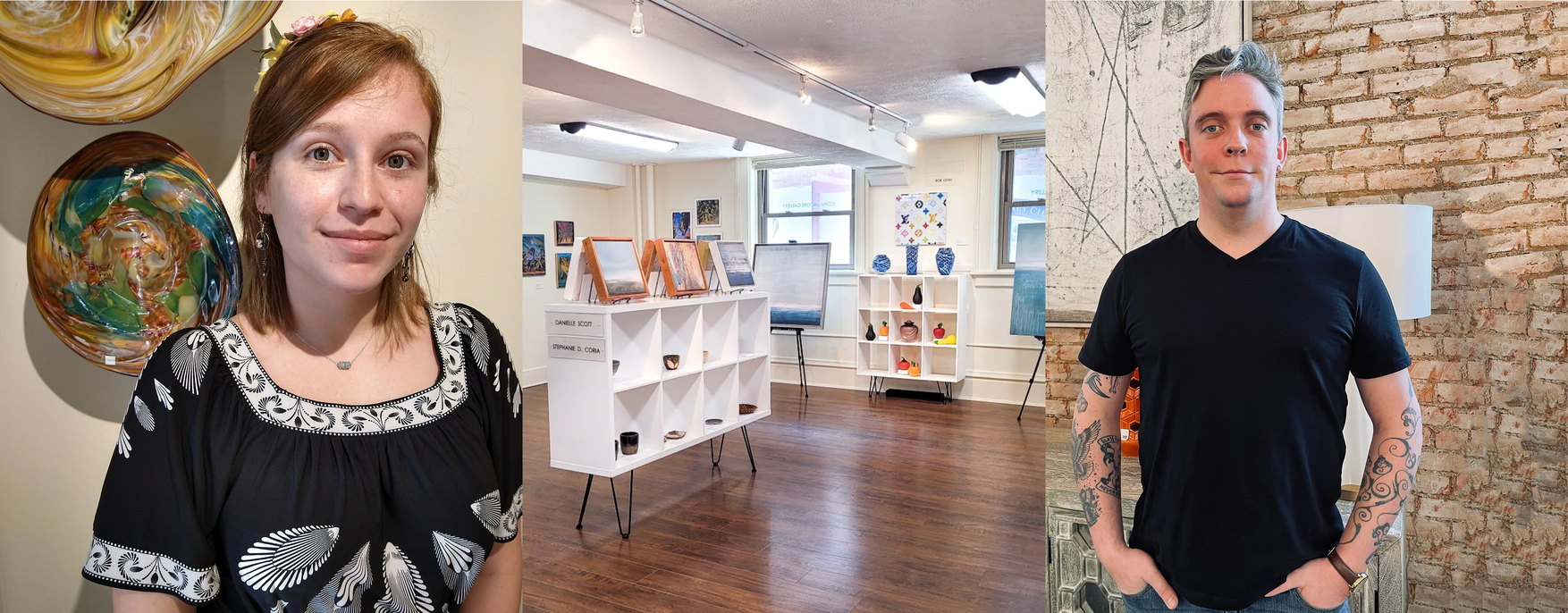One important conversation that all artists, especially women artists need to have, is an honest talk with themselves about how to make their art practice profitable and make a living out of their art.
This “money talk” is still a big taboo in the artistic community, but we sat down with “artpreneur” Crista Cloutier to discuss the myths and stories that limit our growth, and how financial literacy can make a difference in a women’s career path.
Keep reading to find out more about her takes on how to turn your art practice into a business. You can also watch the recorded interview here.
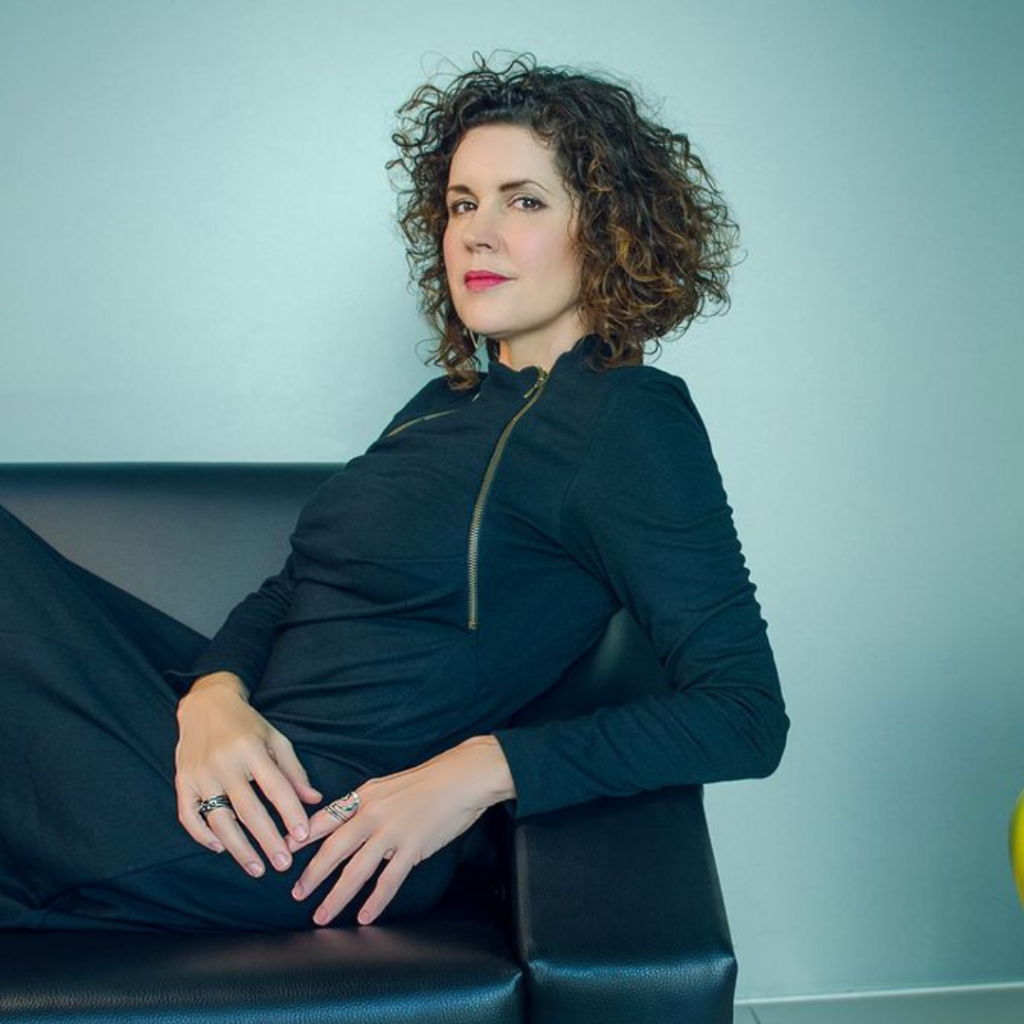
Crista Cloutier is an artist and mastermind behind The Working Artist and its programs.
Can you tell us a bit about your background?
I went to university and studied art. When I graduated, like a lot of art students, I ended up with a lot of debt. I worked my way through school using loans. How do you make a living as an artist? That’s the million-dollar question, isn’t it? I got a day job and I was lucky enough that it was working for a really well-known art studio.
I started as an intern and worked my way up. I was the assistant to the Sales Manager. It turns out that I had a real talent for selling art, which I never knew. Within a year, I had worked my way up to become director of the whole company.
The vast majority of my career was leading that art studio and selling the art that we created in that studio to museums, collectors, and galleries. I was doing everything an artist does, but I was working with other artists to create their work and then I was selling their pieces.
I think at one point I had what I called my “midlife correction”. It wasn’t very pretty. I just remembered that I am an artist and that I had my own things to say. The years that I spent leading this studio were great learning experiences. It was like an apprenticeship.
Many artists have a history of apprenticeship. I learned a lot about the business. I learned about art, I learned about what I wanted to do, but I hadn’t really found my voice. I needed to go somewhere where I could find my own voice and that was Europe.
I moved to Europe all by myself, to the middle of nowhere in France. I didn’t know anyone. I didn’t speak any French. I just needed quiet. From there, I started a new life, and I created an online professional practice program called The Working Artist. For the last ten years, I’ve been working with artists, teaching them how to navigate the art business and how to make a living from their art.
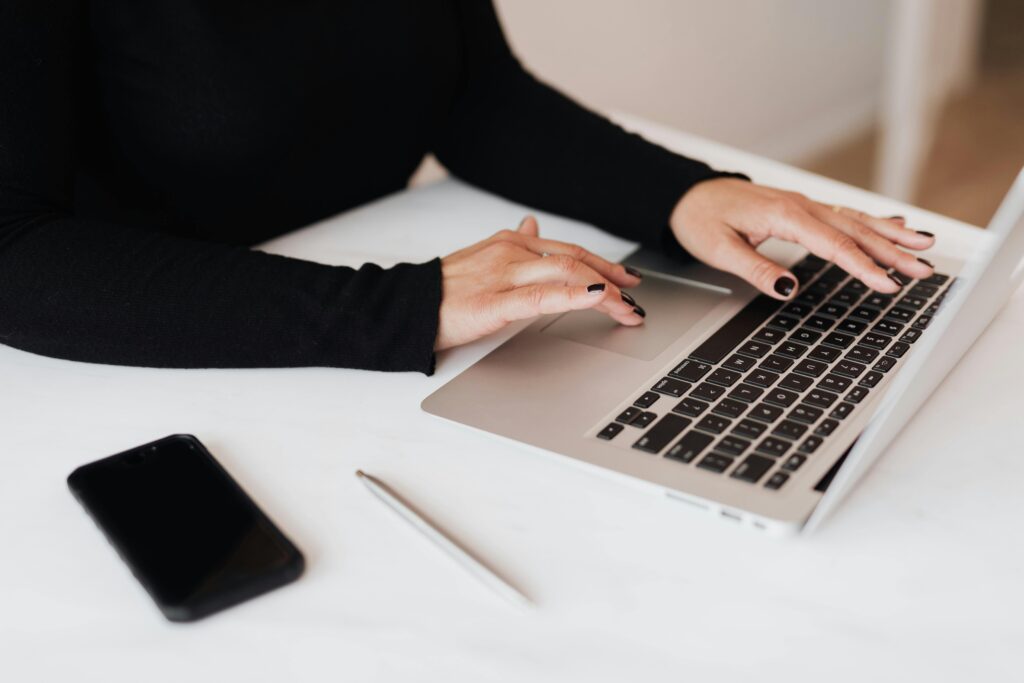
Talking about the different stages of their business is an empowerment move for women artists.
How important is it for women artists to improve their financial literacy?
It’s imperative for all artists, to be honest. Maybe women more so than men, because I think men traditionally are taught more about money and about financial literacy. It’s always been the men’s domain. But I think that’s changing and I think it needs to change.
Empowerment is a great word and empowerment comes from within. It doesn’t come from someone outside empowering us. The lottery doesn’t come and empower us with money. We really have to make the switch in our heads and in our hearts. A lot of that comes from learning about the financial world, learning about dollars and cents and how money works, and also about our own patterns and ideas about money.
It’s an emotional learning experience. I feel like that’s all part of financial literacy and it’s all within our reach. I don’t like math, but I tell a story about a woman I know who wanted to be an architect her whole life, and she ended up becoming a teacher, and yet her whole house was full of books about architecture.
Every single vacation she took was looking at architecture. And I said, “Why didn’t you become an architect?” And she said: “I just couldn’t do the math. Math skills were too difficult for me”. And I thought this woman hated being a teacher. Wouldn’t you rather hate learning math and then get to the other side of that and do what you want to do? But we put these limitations in front of us, and a lot of women especially, we say “I hate math” or “I hate numbers” and we avoid learning about them.
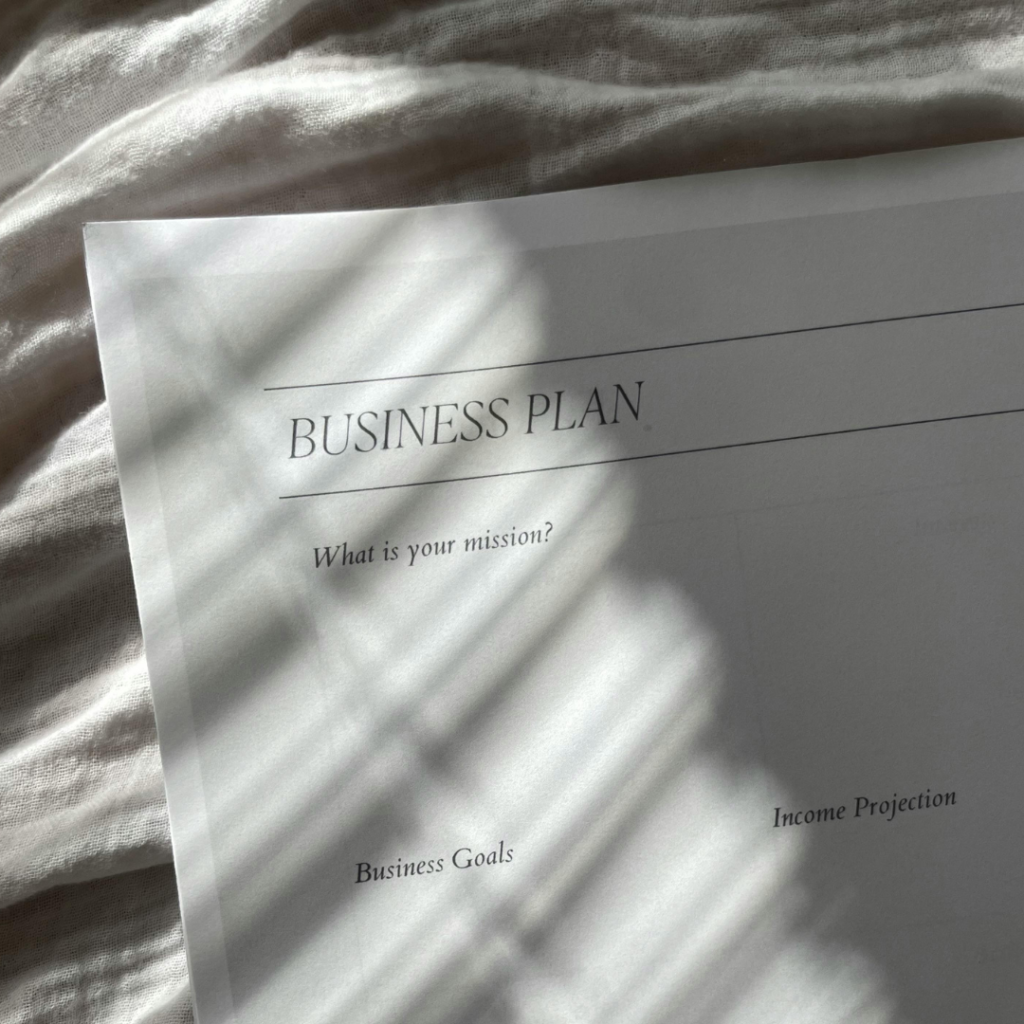
Your business plan is a framework that will help you focus and grow your career.
How important is it for an artist to actually create a business plan? Let’s dive into this money talk.
Business plans used to be big and scary to me. “I’m an artist. I don’t do business”. But if you want to work as an artist, you are doing business, and you have a business like any other. You are an entrepreneur and you are not exempt from a business plan.
A business plan doesn’t have to be a big, scary, horrible thing. It can be really simple, and it’s a matter of just following the steps and putting the pieces in place to create a plan. I just see so many artists working with a “hope” plan like “I hope a gallery or an agent will come to save me”, and that plan never works.
I don’t believe that there are many galleries out there anymore who take care of the whole business for artists, especially an artist who is unknown, and who has never handled their own business. If a gallery is going to come in and represent an artist in the way the old-fashioned galleries did, where they handle everything for them, they want to work with people who already have a foundation.
There’s a gazillion talented artists out in the world right now, but it’s not a question of talent. This is a business. You will save yourself so much time, you will save yourself so much pain, you will save yourself so much money if you put on your big girl pants and approach your business like a business.
Maybe there would be more women in the museums if we were more empowered to treat ourselves seriously first. I think really that’s where it begins, is empowering ourselves and stopping waiting for the world to empower us.
Stop waiting for the museums to say “oh, now we’re opening our doors to women”. Don’t sit there and twiddle your thumbs until someone gives you permission. It starts here, and then we have to go out there. That’s how we’re going to change the world and imagine what the world could be like if women were empowered with their business, with their finances, with the way we spend money, with the way we make money, with the way we talk about money. We could change the whole conversation, but it starts with us.

Knowing how much you really need to earn to sustain your art practice is an essential part of your business plan.
In your ten years working with artists, what are the biggest challenges they usually run into when they’re trying to come up with a business plan and take their practice in a more serious way?
I think this story is very common in many fields. I work a lot with universities and university art students. Sometimes after I give a talk, a young woman will come up to me and ask me questions about the art business. And I will say “tell me about your work” and then they’ll say “it’s not for me, it’s for my partner” or “my partner is an artist too and we’ve decided that I’m going to help him get his career off the ground and then when he’s up here, he’ll help me”.
This seems to be something that I’ve run into a couple of times, if not several times, and it makes me sad. I really want to go back in time and ask them, how did that work out for them. It’s hard enough for anyone to work as an artist. Where do you measure that point where he’s going to turn around and put his hand out and help you?
By that time, maybe you’re having kids, so maybe it never happens. And we all know the stories about the women who put their husbands through medical school, you know what I mean? And then what are they left with? There’s no blame here, because when I look at my own life, I’ve done that a lot too. I put my partners ahead of me. And do I regret it? Yeah, kind of to be honest.
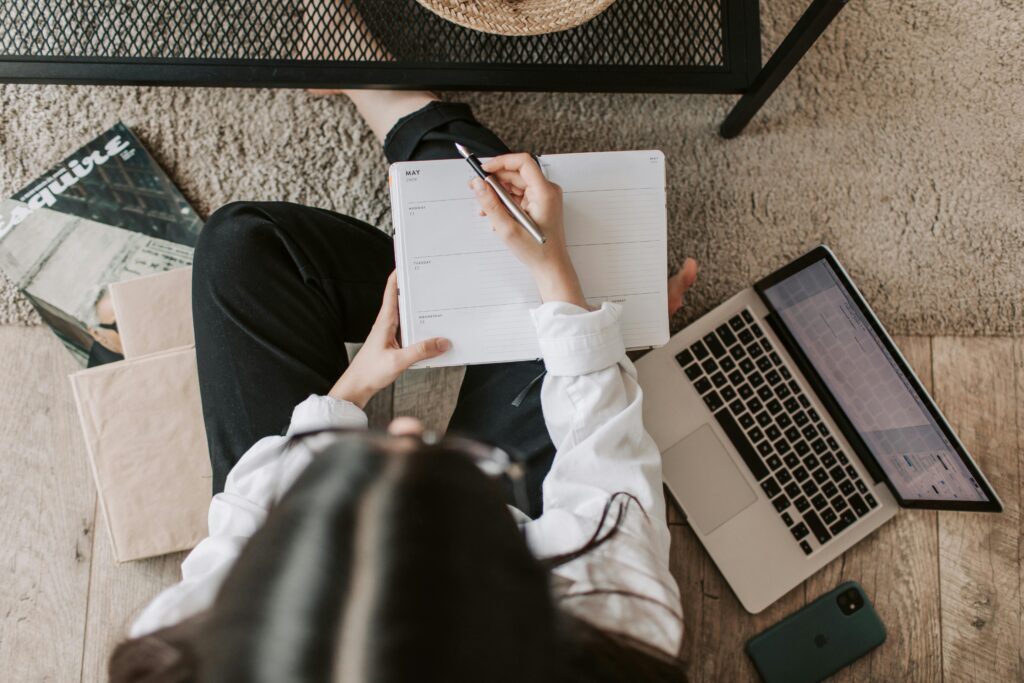
One of the biggest myths that needs to be busted is that the value of your art equals your value as a creator.
Let’s say I’m an artist and I have created my business plan. How can this actually help me navigate the art world? Why is it so crucial to have a business plan?
Well, like I said, hope is not a plan. A business plan gives you numbers, it gives you a sense of direction, and it also shows you what you need to know.
A lot of times, we don’t know what we need to know until we’re asked the questions in a business plan. It’s important to know your values and to put real numbers and real action plans in place. I work with a lot of artists, so part of The Working Artist is creating a business plan.
When I work with artists, I ask them “how much do you need to make every year?” And they’ll say “A million dollars”. I’ll say “Wow, okay, why do you need to make a million dollars?” and then they’ll answer “because that means I’m successful”.
That doesn’t mean you’re successful. It means that you’re really busy. It means you might not be able to do the work you want to do, the kind of work you want to do. It means you’re probably not going to be free.
I mean, there’s nothing wrong with making a million dollars, and you absolutely can make a million dollars. But the first thing I want artists to do is to separate their self worth from their net worth. Your value as an artist is not equal to the amount of money in your bank account.
Those are really important numbers to divorce yourself from. How much money do you need to live and to work? Those are business plan numbers. How much money do you need to prove to your family that you’re not a failure? That’s not business plan numbers. That’s a conversation to have with yourself, to have with your therapist, and to have with other artists too, because I really believe that we’re at a time in history where artists need to be leading these kinds of conversations.
The whole world tells us that our self worth or our value as an artist should be equal to how much money a painting can get and that is absolutely false. But again, we can’t wait for them to change that narrative, we need to change it. They’re not going to take us seriously if we’re not taking our business and ourselves seriously first. Having a business plan really gives you that foundation.
And again, you don’t need to make a million dollars from your work. Part of your business plan might be doing side gigs to support your art. I always say your art is not here to support you, you are here to support your art. What does that mean? It means that just because you put pen to paper or a brush to canvas, it doesn’t mean that suddenly your work needs to go out in the world and earn a living.
If you want that to happen, you need to earn a living to support that art, to find your voice, your true voice, to improve your craft, to understand the business of art, to build an audience, all of that. And if that means having a side gig or several side gigs, that’s okay.
I ran away to France to find my own voice and develop my craft, and it’s taken me a long time to do it. I created The Working Artist to be my side gig. Did this plan pay off? Absolutely! I’ve built an audience. I have found my voice and I have developed my craft. Now I’m showing internationally, I’m publishing a book. It’s a marathon, not a sprint.
I remember when I started, people said “well, you could be 50 or 60 years old before you see any success with your plan”, and I thought “I’m going to be 50 or 60 years old anyway, how do I want to spend those years? What do I want my side gig to look like? And how can it feed my work?”
If you’re here to support your art, it doesn’t matter if you’re 20 and just out of school and starting and have a bunch of debt, if you’re a mid-career artist, or if you’re struggling to balance your daily life with your artistic practice. If you’re putting your art at the center of everything, then it’s easier to start drafting goals that are actually realistic and that can turn into a proper business plan that can sustain your practice.

Setting realistic goals will put you on the path to success.
You said, hope is not a goal. How can an artist set realistic financial and business goals? What are the realistic types of goals that we’re looking for?
Well, how much money do you really need? How much money does it cost to make your art realistically? How much money can your art bring in? You can make fabulous art but you might be living in a market that doesn’t support that. Your prices really have to be based on real world market numbers, and these aren’t a reflection of the quality of your work.
Sometimes artists live in the middle of nowhere, and they’re showing out of the local town gallery, and those people just can’t afford New York City prices. I see artists beat themselves up or get really angry at their market but you have to respond to your market. The numbers have to be based on reality.
This is especially important for women. I believe that you really have to deal with your own money demons and get all those stories out of your way, like, understand what your money stories are. Especially as women, and especially as artists, we get told a lot of false money stories.
For the audience, how would you define these money stories?
Well, I do an exercise with artists where I take them through meditation, and I have them sit in a room, and I have money come into this room and sit across from them, and I have them listen to what money has to say.
Some of them are like “I don’t want to listen to money. Money has nothing to say”. When I did the exercise the first time, money was so mean to me, and money was just telling me basically, that I’m never going to be worthy, that I don’t do enough, that I don’t have enough, that I’m not good enough.
And it’s like a wow moment, there’s not really someone named Money sitting across from me. So where is this coming from? Then I realized these are stories I’ve heard through my family, through the culture, through my partners, through maybe a bad experience that I’ve internalized in a certain way.
We are nothing more than the compilation of our stories. Our whole success is the compilation of these stories that we tell ourselves. The only person who can change those stories is us.
Knowing what those stories are and really listening to them, identifying where they come from, then doing the work to change those stories and working with your numbers so the fears and the judgments are not married to those numbers anymore. That is a very powerful recipe for success.
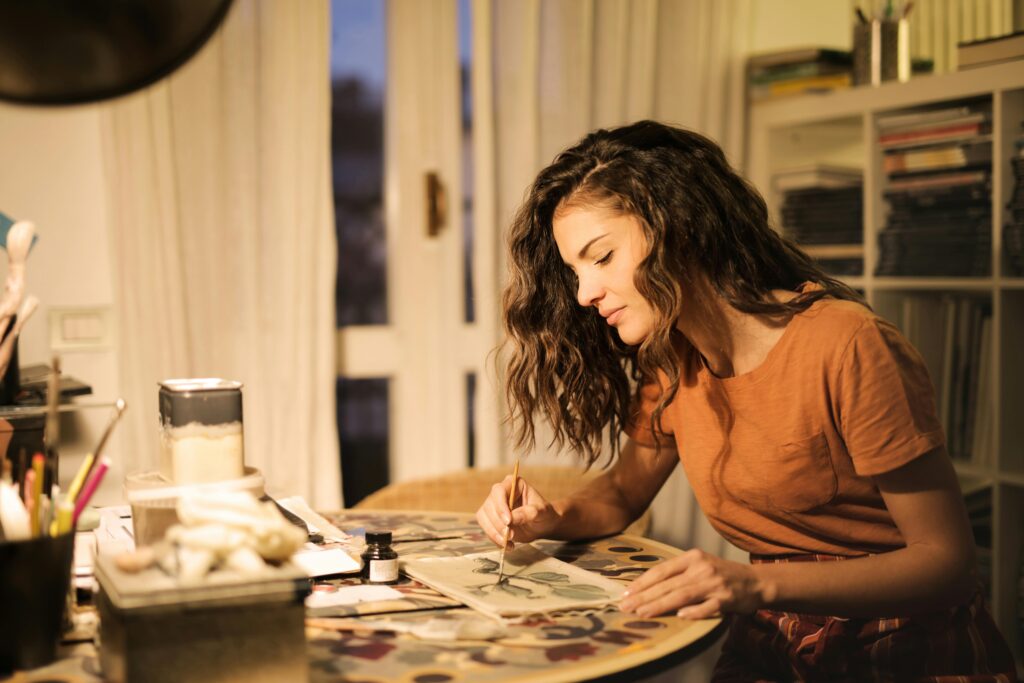
One of Crista’s greatest pieces of advice to women artists is “marry creativity into what you are doing”.
In your opinion, is there a way to find a balance, particularly between the business side and the creative side?
It’s such a hard balance, no one does it gracefully. I think that’s the first thing to understand. I don’t do it gracefully. I don’t know. I work with women who are world famous artists. Some are mothers, some are not. Neither one does it gracefully.
We’re all floundering this time management and we can never really win. I think it comes back to the story. I think it comes back to acceptance. My favorite word is grace. I aspire to feel graceful in my creative work. I aspire to feel graceful in my business and in my personal relationships.
Am I always that way? No, not at all. There’s a lot of wailing and gnashing of teeth in my world too. But it’s practice, right? If we can get back to that graceful place, it’s a practice. The more we can get ourselves back there, the more we can feel graceful, because that’s what we’re all looking for in this work life.
Balance is just to feel graceful. Part of that is accepting that in this dance of creativity and work, sometimes the creativity gets to lead, and that’s really fun. Sometimes the business has to lead, and it’s not as much fun. If we could stop beating ourselves up for what we’re not doing and give ourselves wholly to what we are doing. That ‘s my goal.
I have found it really helpful in my business plan to include a time management plan, like every quarter. These are my goals for the quarter. These are my goals for the month. Am I actually meeting those goals? When I’m working on creative work, I’m aware of what my goals are. Am I doing that or do I need to make some adjustments? Because you always have to be open.
You have to dance the dance. And I think for mothers, especially young mothers or mothers of young families, this becomes especially challenging because we really need to be with our children. It’s really easy to think that you are kicked out of the art club. Once you wear that mom badge, you’re not allowed to be an artist anymore. That’s not true and it’s not fair.
I tell mothers that I work with, to make creative time with their kids as much as they can.
Marry your creativity into what you’re doing as a mom. That’s beautiful. You get to be in the art club. If you can set some really gentle goals for yourself, do that so that you know that you still got your foot in that world. That’s okay. That’s enough.

Talking about money and money goals is a way to break taboos and tap into important conversations that lead to self-growth.
Why is it so uncomfortable to talk about these subjects? How can we break that idea or that story and make it a more friendly conversation?
Because money has been used for centuries to enslave us. Now, money is not something that really exists. It’s not something that was in the Garden of Eden. It’s not something in nature. It’s something that we created simply to facilitate exchange.
Money was sent here to serve us, but it’s been subverted into this thing that has come to enslave us. We are afraid of it. We give it much more power than it deserves. We think it’s the only resource we have. We think it’s going to save us. We think it’s the only currency but it’s not.
There are other currencies that are much more powerful than money, such as relationships. or our energy. That’s why I talk about stories because that’s really all about energy. Having these conversations about money, being able to look at our own money story and look at our own numbers, empowers us and helps us to change the culture.
Why don’t we even teach about money in school, really? Instead, we’re all raised to fear money. We’re all waiting, saying “If I had more money, then I could do this. If I had more money, I would be this”. Don’t do that. Do it anyway. Take the leap because that’s when the net appears. The universe supports you.
I think as women, that’s where we can also help build a new paradigm, because we’re all about relationships, we’re all about working. We’ve been very thrifty for many years because we haven’t been in charge of the money. We know how to make the world work with money as a resource, but not the only resource.

Take the leap: when you put your art first a net of fellow artists will appear to help you navigate this new journey.
What strategies or what advice do you have for women artists who are trying to get more confident when it comes to their finances, their art practice and how to make it profitable?
I go back to what I said earlier about the stories we tell ourselves. Do that exercise. Do a meditation that I was describing where you sit quietly and invite money to come and sit in a chair across from you.
Listen to the stories that money is telling you about yourself. Money is a mirror for us. Really listen to that and see what’s getting in your way and where you’re getting in your own way. Then look at your numbers, look at what you truly need, not just what you want. Needs versus wants are two different things.
How much are you bringing in? Maybe that number is zero or a number very close to zero. Don’t be afraid of that. Don’t curse it. Everything you’re doing is to empower you. Don’t be afraid of it or run away from it. It’s about educating and then learning more about how finances work.
It’s kind of something you never need to stop learning. There’s always more and more. Once you start making money you can learn about investing, for example, investing in art, maybe other people’s art. I encourage artists to invest in other artists’ work.
I love that because the community contributes to their own community. And in that same way, we can give others the push that someone gave us. We can do it for other artists when we get to that stage.
Try to support the things you want support from. We want support from the art, the greater art world, the museums, the nonprofits. Why don’t we support them, too? How can we best support them? How can it be an exchange? Money is supposed to be an exchange, and what happens is that too many people hold on to it.
People believe there’s only so much money in the world, and if they don’t have it then someone else is going to get it. I don’t believe that’s true. I believe that there’s plenty of money in the world. And if we all just let go and we start that dance of the exchange, it’s going to change the world profoundly.
It’s learning to let go of ourselves first and let go of that fear. There’s great value in learning to live. We live in a culture where we are constantly told that you need bigger, that you need more, that you need newer. How much stuff do we really need?
Certainly, when I was an art dealer, I was part of that culture. I had a really big house with storage, with an attic, and everything was just full of stuff, and I couldn’t stop buying stuff. And that was why I wasn’t free when I wanted to leave because I’d spent all my money on stuff.
Eventually, I just got rid of all that stuff, which was really hard to do because I realized that I was starting to identify myself with my stuff. That was a real addiction that was a painful addiction to break.
Artists are much more effective as artists if we can be free. That’s how we weather financial storms, that’s how we are able to do a big project that is kind of outside of our realm. If we can be free and not be tied to stuff, it helps us to catapult to wherever we want to go. It gives us a lot more mobility in all kinds of ways.
Editor’s note this interview was edited for length and clarity.
